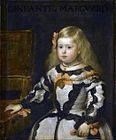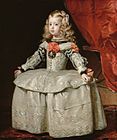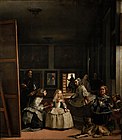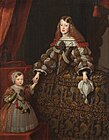Margaret Theresa of Spain
| Margaret Theresa of Spain | |
|---|---|
 Portrait by Gerard du Chateau, 1665 | |
| Holy Roman Empress | |
| Tenure | 25 April 1666 – 12 March 1673 |
| Born | 12 July 1651 Royal Alcazar, Madrid, Crown of Castile |
| Died | 12 March 1673 (aged 21) Hofburg Palace, Vienna, Archduchy of Austria, Holy Roman Empire |
| Burial | |
| Spouse | |
| Issue Detail | Maria Antonia, Electress of Bavaria |
| House | Habsburg |
| Father | Philip IV of Spain |
| Mother | Mariana of Austria |
Margaret Theresa of Spain (Spanish: Margarita Teresa, German: Margarete Theresia; 12 July 1651 – 12 March 1673) was, by marriage to Leopold I, Holy Roman Empress, German Queen, Archduchess of Austria and Queen of Hungary and Bohemia. She was the daughter of King Philip IV of Spain and the elder full-sister of Charles II, the last of the Spanish Habsburgs. She is the central figure in the famous Las Meninas by Diego Velázquez, and the subject of many of his later paintings.
Biography
[edit]Early years
[edit]Margaret Theresa was born on 12 July 1651 in Madrid as the first child of King Philip IV of Spain born from his second marriage with his niece Mariana of Austria. Because of this avunculate marriage, Margaret's mother was nearly thirty years younger than her father.[1]
Margaret's paternal grandparents were King Philip III of Spain and his wife Archduchess Margaret of Austria. Her maternal grandparents were Ferdinand III, Holy Roman Emperor and his wife Infanta Maria Anna of Spain, the daughter of her paternal grandparents.[1][2]
The marriage of her parents was purely made for political reasons, mainly the search for a new male heir for the Spanish throne after the early death of Balthasar Charles, Prince of Asturias in 1646. Besides him, the other only surviving child of Philip IV's first marriage was the Infanta Maria Theresa, who later became the wife of King Louis XIV of France. After Margaret, between 1655 and 1661, four more children (a daughter and three sons) were born from the marriage between Philip IV and Mariana of Austria, but only one survived infancy, the future King Charles II of Spain.[1][3]
Despite the close consanguinity of her parents, Margaret did not develop the serious health issues and disabilities that her younger brother had shown since his birth. During her childhood, she was once seriously ill, but survived.[4] According to contemporaries, Margaret had an attractive appearance and lively character. Her parents and close friends called her the "little angel". She grew up in the queen's chambers in the Royal Alcazar of Madrid surrounded by many maids and servants.[5] Both Margaret's father and maternal grandfather Emperor Ferdinand III loved her deeply. In his private letters King Philip IV called her "my joy".[6] At the same time, Margaret was brought up in accordance with the strict etiquette of the Madrid court, and received a good education.[7][8]
Betrothal and marriage
[edit]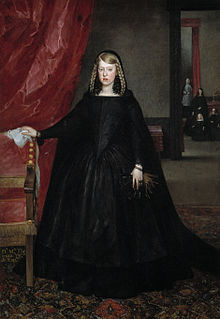
In the second half of the 1650s at the imperial court in Vienna the necessity developed for another dynastic marriage between the Spanish and Austrian branches of the House of Habsburg. The union was needed to strengthen the position of both countries, especially against the Kingdom of France. At first the proposals were for Maria Theresa, the eldest daughter of Philip IV, to marry the heir of the Holy Roman Empire, Archduke Leopold Ignaz. But in 1660 and under the terms of the Treaty of the Pyrenees, Maria Theresa was married to the French King, Louis XIV; as a part of her marriage contract, she was asked to renounce her claims to the Spanish throne in return for a monetary settlement as part of her dowry, which was never paid.[9]
Then began discussion about a marriage between Margaret and the Holy Roman Emperor Leopold I (who was her maternal uncle and paternal cousin). However, the Madrid court hesitated to agree to this proposal, because the infanta could inherit the Spanish crown if her little brother died.[10] The count of Fuensaldaña, Spanish ambassador in France, suggested the infanta as a possible bride for King Charles II of England. However, King Philip IV rejected this idea, replying that the King of England should look for a wife in France.[11]
In October 1662, the new Imperial ambassador in Spain, Count Francis Eusebius of Pötting, began one of his main diplomatic assignments, which was the celebration of the marriage between the infanta and the emperor.[12] Negotiations by the Spanish side were led by Ramiro Núñez de Guzmán, Duke of Medina de las Torres.[13] On 6 April 1663, the betrothal between Margaret and Leopold I was finally announced. The marriage contract was signed on 18 December. Before the official wedding ceremony (which, according to custom, had to take place in Vienna) another portrait of the infanta was sent, in order for the emperor to know his bride.[2]
King Philip IV died on 17 September 1665. In his will, he did not mention Margaret's betrothal; in fact, the context in which the document was prepared suggests that the late monarch still hesitated to marry his daughter to his Austrian relative because he sought to ensure her rights as sole ruler of the Spanish crown in case of the extinction of his male line.[14] Mariana of Austria, now Dowager Queen and Regent of the kingdom on behalf of her minor son Charles II, delayed the wedding of her daughter. The marriage was agreed upon only after intense Imperial diplomatic efforts. On 25 April 1666, the marriage by proxy was finally celebrated in Madrid, in a ceremony attended not only by the Dowager Queen, King Charles II and the Imperial ambassador but also by the local nobility; the groom was represented by Antonio de la Cerda, 7th Duke of Medinaceli.[15]

On 28 April 1666 Margaret traveled from Madrid to Vienna, accompanied by her personal retinue. The infanta arrived at Dénia, where she rested for some days before embarking on the Spanish royal fleet on 16 July, in turn escorted by ships of the Order of Malta and the Grand Duchy of Tuscany. Then (after a short stop in Barcelona because Margaret had some health issues)[16] the cortege sailed to the port of Finale Ligure, arriving on 20 August. There, Margaret was received by Luis Guzman Ponce de Leon, Governor of Milan. The cortege left Finale on 1 September and arrived in Milan ten days later, although the official entry was not celebrated until 15 September. After spending almost all September in Milan, the infanta continued the journey through Venice, arriving in early October in Trento. At every stop Margaret received celebrations in her honor. On 8 October the Spanish retinue arrived at the city of Roveredo, where the head of Margaret's cortege, Francisco Fernández de la Cueva, 8th Duke of Alburquerque officially handed the infanta to Ferdinand Joseph, Prince of Dietrichstein and Count Ernst Adalbert von Harrach, Prince-Bishop of Trent, representants of Leopold I. On 20 October the new Austrian cortege left Roveredo, crossing the Tyrol, through Carinthia and Styria, and arrived on 25 November at the district of Schottwien, twelve miles from Vienna where the emperor came to receive his bride.[15]
Holy Roman Empress and German Queen
[edit]The infanta formally entered Vienna on 5 December 1666. The official marriage ceremony was celebrated seven days later. The Viennese celebrations of the imperial marriage were among the most splendid of all the Baroque era,[17] and lasted almost two years.
The emperor ordered the construction of an open-air theatre near the present Burggarten, with a capacity of 5,000 people. For Margaret's birthday in July 1668, the theatre hosted the premiere of the opera Il pomo d'oro (The Golden Apple). Composed by Antonio Cesti, the opera was called the "staging of the century" by contemporaries due to its magnificence and expense.[18] The year before, the emperor gave an equestrian ballet where he personally mounted on his horse, Speranza; due to technical adaptations, the ballet gave spectators the impression that horses and carriages were hovering in the air.[19]
Despite the age difference, Leopold I's unattractive appearance and Margaret's health problems, according to contemporaries they had a happy marriage. The empress always called her husband "Uncle" (de: Onkel), and he called her "Gretl" (a German diminutive of Margaret).[20] The couple had many common interests, especially in art and music.[21]
During her six years of marriage, Margaret gave birth to four children, of whom only one survived infancy:[1]
- Ferdinand Wenceslaus Joseph Michael Eleazar (28 September 1667 – 13 January 1668), Archduke of Austria.[22]
- Maria Antonia Josepha Benedicta Rosalia Petronella (18 January 1669 – 24 December 1692), Archduchess of Austria,[22] who inherited her mother's claims to the Spanish throne, married Maximilian II Emanuel, Elector of Bavaria and was the mother of Joseph Ferdinand of Bavaria.
- John Leopold (born and died 20 February 1670), Archduke of Austria.[22]
- Maria Anna Josepha Antonia Apollonia Scholastica (9 February 1672 – 23 February 1672), Archduchess of Austria.[22]
The empress reportedly inspired her husband to expel the Jews from Vienna, because she believed that they were to blame for her children's deaths. During the Corpus Christi celebration of 1670, the emperor ordered the destruction of the Vienna synagogue and a church was built on the site on his orders.[21]
Even after her marriage, Margaret kept her Spanish customs and ways. Surrounded almost exclusively by her native retinue (which included secretaries, confessors, and doctors), she loved Spanish music and ballets and therefore hardly learned the German language.[21]
Death
[edit]Weakened due to six pregnancies in six years (which included four living childbirths and two miscarriages[20]) and four months into her seventh pregnancy,[23] Margaret died on 12 March 1673, at the age of 21. She was buried in the Imperial Crypt, in Vienna. Only four months later, the widower emperor – despite his grief for the death of his "only Margareta" (as he remembered her)[24] – entered into a second marriage with Archduchess Claudia Felicitas of Austria, member of the Tyrolese branch of the House of Habsburg.[21]
After Margaret's death, her rights over the Spanish throne were inherited by her only surviving daughter Maria Antonia, who in turn passed them to her only surviving son Prince Joseph Ferdinand of Bavaria when she died in 1692. After Joseph Ferdinand's early death in 1699, the rights of inheritance were disputed by both Emperor Leopold I and King Louis XIV of France, son-in-law of King Philip IV. The outcome of the War of the Spanish Succession was the creation of the Spanish branch of the House of Bourbon in the person of King Philip V, Margaret's great-nephew.[21]
Depictions in art
[edit]Shortly before the birth of Margaret, painter Diego Velázquez returned to the Spanish court in Madrid. From 1653 to 1659 a series of portraits of the infanta were painted. Three of them – "Infanta Margarita Teresa in a Pink Dress" (1653), Infanta Margarita in a White and Silver Dress (1656) and Infanta Margarita Teresa in a Blue Dress (1659) were sent to the Imperial court in Vienna, and now are displayed in the Kunsthistorisches Museum.[25] In the last paintings of the 8-year-old infanta made by Velázquez, a more mature and formal attitude of Margaret can be seen, due to her upcoming marriage to the emperor.[26]
The most famous painting by Velazquez in the series of portraits of the infanta was Las Meninas (1656), currently in the Museo del Prado in Madrid. In it, the artist painted the 5-year-old infanta in his studio while working on a portrait of her parents. She is surrounded by her maids of honor and other courtiers, but her eyes are riveted to her parents, whose reflection is visible in the mirror on the wall.[27] The canvas was the inspiration for Picasso, who in 1957 created more than forty variations of this pattern.[28]
The image of Margaret in the paintings by Velázquez inspired not only painters. The poet Boris Pasternak mentions it in a poem of 1923 "Butterfly Storm", in which she appears to him as a vision during a thunderstorm in Moscow.[29] The first image in this poem who Pasternak contrasted with the portraits of the Infanta was mentioned by Vyacheslav Vsevolodovich Ivanov, in his work "Eternal Childhood".[30][31]
The Infanta Margarita Teresa in a Pink Dress (1660), formerly credited to Velázquez, is now considered one of the masterpieces of his son-in-law, Juan Bautista Martínez del Mazo. To Martínez del Mazo also belongs the latter "Portrait of the Infanta Margarita in mourning dress" (1666), in which she is depicted shortly after her father's death and shortly before her wedding. Both paintings are also included in the collection of the Museo del Prado.[32] The authority of the "Portrait of the Infanta Margarita" (1655) currently at the Louvre, is still questioned by researchers.[33]
There are portraits of an adult Margaret by a number of European artists, most of which are stored in the collections of the Kunsthistorisches Museum in Vienna. Among them, "a full-length portrait of the Infanta Margarita Teresa, the Empress" (1665) by Gerard Du Chateau[34] and "Portrait of Empress Margarita Teresa in a theatrical costume" (1667) by Jan Thomas van Ieperen.[35] One of the last portraits of Margaret is the "Portrait of Empress Margarita Teresa and her daughter Maria Antonia" (c. 1670) by Jan Thomas van Ieperen, currently in the Hofburg, where she is depicted with her only surviving child.[36] Numerous copies of her portraits are also preserved, and are now kept in the museum collections around the world.
-
Infanta Margarita Teresa in a Pink Dress (1653), Velázquez, Kunsthistorisches Museum, Vienna
-
Infanta Margarita Teresa (1655), Velázquez, Musée du Louvre, Paris
-
Infanta Margarita in a White and Silver Dress (1656), Velázquez, Kunsthistorisches Museum, Vienna
-
Las Meninas (1656), Velázquez, Prado Museum, Madrid
-
Infanta Margarita Teresa in a Blue Dress (1659), by Velázquez, Kunsthistorisches Museum, Vienna
-
Infanta Margarita Teresa in a Pink Dress (1660) by Velázquez or Juan Bautista Martínez del Mazo, Prado Museum, Madrid
-
Infanta Margaret Theresa, Empress, in theater dress (1667) by Jan Thomas van Ieperen, Kunsthistorisches Museum, Vienna
-
Empress Margarita Teresa and her daughter Maria Antonia (c. 1670) by Jan Thomas van Ieperen, Hofburg Palace, Vienna
Ancestors
[edit]References
[edit]- ^ a b c d Louda, Jirí; MacLagan, Michael (1999). Lines of Succession: Heraldry of the Royal Families of Europe (2nd ed.). London: Little, Brown and Company. tables 80, 81.
- ^ a b Martin Mutschlechner: Philip IV: marriage and offspring in: habsburger.net [retrieved 27 October 2016].
- ^ Antonio Álvarez-Ossorio Alvariño: La sacralización de la dinastía en el pulpito de la Capilla Real en tiempos de Carlos II, pp. 315–317 (in Spanish) [retrieved 27 October 2016].
- ^ Olivan Santaliestra 2014, pp. 174–176.
- ^ Olivan Santaliestra 2014, p. 174-182.
- ^ Museum of Art History, Moscow: Directmedia 2014, vol. XXVI, pp. 89–95 (The great museums of the world). ISBN 978-5-87-107267-7.
- ^ Olivan Santaliestra 2014, pp. 166, 176–183.
- ^ Luis Tercero Casado: La última emperatriz española: Margarita Teresa en el Hofburg in: vienadirecto.com (in Spanish) [retrieved 27 October 2016].
- ^ W. R. de Villa-Urrutia: Relaciones entre España y Austria durante el reinado de la emperatriz Doña Margarita, Infanta de España, Esposa del emperador Leopoldo I, Madrid: Libreria de Fernando Fe 1905, pp. 67–69.
- ^ Laura Oliván Santaliestra: Mariana de Austria en la encrucijada política del siglo XVII Archived 9 November 2020 at the Wayback Machine, Madrid: Universidad Complutense de Madrid, 2006. p. 304.
- ^ Valladares, Rafael: La rebelión de Portugal: guerra, conflicto y poderes en la monarquía hispánica, 1640–1680, Valladolid: Junta de Castilla y León, 1998, p. 176.
- ^ Jaroslava Kašparová: Po stopách knižní sbírky Františka Eusebia hraběte z Pöttingu a Persingu (1626–1678) Archived 22 August 2016 at the Wayback Machine in: www.nm.cz [retrieved 27 October 2016].
- ^ Laura Oliván Santaliestra: Mariana de Austria en la encrucijada política del siglo XVII Archived 9 November 2020 at the Wayback Machine, Madrid: Universidad Complutense de Madrid, 2006. p. 184.
- ^ M. V. López-Cordón, J. M. Nieto Soria: El Testamento de Felipe IV: atencion al problema sucesorio – Gobernar en tiempos de crisis: las quiebras dinásticas en el ámbito hispánico, 1250—1808, Madrid: Silex Ediciones 2008, pp. 48–50 ISBN 978-8-47-737215-8.
- ^ a b A. Rodríguez Villa: Dos viajes regios (1679–1666), Boletín de la Real Academia de la Historia 1903 N° 42, pp. 369–381.
- ^ Verdadera relación de las fiestas y recibimiento que en Barcelona se hizo á la Majestad Cesárea de la Serma. Sra. D.a Margarita de Austria, emperatriz de Alemania, y juntamente de su embarcaciór, Y acompañamíento, Madrid 1666
- ^ Friedrich Polleross: Entre "majestas" y "modestas": sobre la representación del emperador Leopoldo I (in Spanish). For more information about the celebrations see: Verdadera relación de la entrada y recibimiento que se hizo á la Sra. Emperatriz de Alemania, D. Margarita de Austria, en la ciudad de Viena, en cinco de Diciembre del año pasado de 1666, Granada, 1666.
- ^ Pomp and circumstance: the baroque opera Il pomo d’oro in: europeanasounds.eu [retrieved 28 October 2016].
- ^ Julia Teresa Friehs: Party-time: The marriage of Leopold I and Margarita of Spain in: habsburger.net [retrieved 28 October 2016].
- ^ a b Bernhard Kathan: Frühe Gebärmaschinen in: hiddenmuseum.net [retrieved 28 October 2016].
- ^ a b c d e Alfred A. Strnad: Margarethe (Margarita Maria Teresa), Infantin von Spanien in: deutsche-biographie.de [retrieved 28 October 2016].
- ^ a b c d Theodor Berger: Die Durchläuchtige Welt, Oder: Kurtzgefaßte Genealogische ..., Vol. 1 [retrieved 28 October 2016].
- ^ "KAISERIN MARGARITA TERESA *12.07.1651 Madrid, Spanien – †12.03.1673 Wien". kapuzinergruft.com (in German). Retrieved 13 May 2022.
- ^ Wheatcroft 1997, p. 201.
- ^ Velázquez. Kunsthistorisches Museum Wien Archived 18 September 2016 at the Wayback Machine [retrieved 28 October 2016].
- ^ Eva-Bettina Krems: Dynastische Identität und europäische Politik der spanischen Habsburger in den 1650er Jahren
- ^ Diego Rodríguez de Silva y Velázquez: Las Meninas in: museodelprado.es [retrieved 28 October 2016].
- ^ A. G. Kostenevich: Picasso – The Art of Leningrad 1982, pp. 43–226.
- ^ D. S. Likhachev, T. B. Knyazevskaya: Literature and Art in the system of culture, B. B. Piotrowski: Moscow Science 1988, pp. 476–500 ISBN 978-5-02-012677-0.
- ^ Vyacheslav Ivanov: "Eternal Childhood" Pasternak, Literature and Art in the culture system. – Moscow Science, 1988, pp. 471–480.
- ^ B. Pasternak: Complete Works applications: Poetry and poems 1912–1931, D. V. Tevekelyan DV Moscow 2003, pp. 505–573 ISBN 978-5-85-050680-3.
- ^ Juan Bautista Martínez del Mazo: Doña Margarita de Austria in: museodelprado.es [retrieved 28 October 2016].
- ^ Polémica sobre la autoría de un Velázquez prestado por el Museo del Louvre in: elcultural.com Archived 11 September 2016 at the Wayback Machine [retrieved 28 October 2016].
- ^ Infantin Margarita Teresa (1651–1673), Kaiserin, Bildnis in ganzer Figur in: khm.at [retrieved 28 October 2016].
- ^ Infantin Margarita Teresa (1651–1673), Kaiserin, im Theaterkostüm in: khm.at [retrieved 28 October 2016].
- ^ Retrato de la Emperatriz Margarita Teresa de Austria in: internationalportraitgallery.blogspot.ru [retrieved 28 October 2016].
Bibliography
[edit]- Andics, Hellmut, Die Frauen der Habsburger (Vienna: Jugend und Volk, 1985). In German.
- Beutler, Gigi, Die Kaisergruft (Vienna, 2001). In German.
- Hamann, Brigitte, Die Habsburger: Ein Biografisches Lexicon (Munich: Piper, 1988). In German.
- Ingrao, Charles W., Editor and author, In Quest and Crisis: Emperor Joseph I and the Habsburg Monarchy, Hardcover: 278 pages, Purdue University Press (1 June 1979), in English, ISBN 0-911198-53-9, ISBN 978-0-911198-53-9
- Ingrao, Charles W., The Habsburg Monarchy, 1618–1815 (New Approaches to European History) [Paperback], # Paperback: 288 pages, Cambridge University Press; 2 edition (2 October 2000), in English, ISBN 0-521-78505-7, ISBN 978-0-521-78505-1
- Kann, Robert A., A History of the Habsburg Empire, 1526–1918, Paperback, 661 pages, University of California Press, edition (26 November 1980), in English ISBN 0-520-04206-9 ISBN 978-0520042063.
- Kann, Robert A., The Peoples of the Eastern Habsburg Lands, 1526–1918 (History of East Central Europe), [Hardcover],# 464 pages, Univ of Washington Press, (July 1984), in English, ISBN 0-295-96095-7, ISBN 978-0-295-96095-1
- Magosci, Paul Robert, ´´Historical Atlas of Central Europe (History of East Central Europe, Vol. 1, 1), Paperback: 288 pages, University of Washington Press, in English, Revised Exp edition (October 2002), ISBN 0-295-98146-6, ISBN 978-0-295-98146-8
- Olivan Santaliestra, Laura, "My sister is growing up very healthy and beautiful, she loves me" – The Childhood of the Infantas Maria Teresa and Margarita Maria at Court, pp. 165–185 in: Grace E. Coolidge – The Formation of the Child in Early Modern Spain, Farnham: Ashgate Publishing 2014, ISBN 978-1-47-242880-6
- Wheatcroft, Andrew, "The Habsburgs, Embodiyng Empire" [Paperback], 416 pages, Penguin Books, (Non-Classics) (1 May 1997), in English, ISBN 0-14-023634-1, ISBN 978-0-14-023634-7
External links
[edit]- Infanta Margarita Teresa in Blue Dress at the Kunsthistorisches Museum, Vienna
Royal titles
[edit]- Austrian consorts
- Spanish infantas
- 1651 births
- 1673 deaths
- Burials at the Imperial Crypt
- Deaths in childbirth
- Nobility from Madrid
- Children of Philip IV of Spain
- Austrian princesses
- Queens consort of Bohemia
- Holy Roman Empresses
- Queens consort of Hungary
- Duchesses of Teschen
- Spanish people of Austrian descent
- 17th-century House of Habsburg
- 17th-century Austrian people
- 17th-century Spanish people
- Wives of Leopold I, Holy Roman Emperor
- Daughters of kings
- 17th-century Spanish women
- 17th-century Austrian women
- Heirs presumptive
- Daughters of dukes
- Daughters of counts


